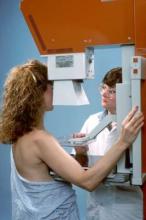For asymptomatic women at average risk of breast cancer, the American Cancer Society recommends annual mammograms from age 45 until age 54, with a transition to biennial screening mammography starting at age 55, according to new guidelines published Oct. 20.
This is the first time the American Cancer Society (ACS) has updated its breast cancer screening guidelines since 2003. The new version makes several changes, including shifting the start of annual mammography from age 40 to 45 years, and increasing the suggested screening interval for postmenopausal women (JAMA. 2015;314[15]:1599-1614. doi:10.1001/jama.2015.12783).
The video associated with this article is no longer available on this site. Please view all of our videos on the MDedge YouTube channel.
For the first time, the guidelines address the question of when to stop routine mammography, recommending a halt to routine screening for women with a life expectancy under 10 years. The ACS guidelines also recommend against clinical breast examinations at any age.
These changes bring the ACS guidelines more into line with recommendations from the U.S. Preventive Services Task Force, Dr. Nancy L. Keating and Dr. Lydia E. Pace, both of Brigham and Women’s Hospital, Boston, wrote in an editorial accompanying the report.
The two organizations are now in agreement on most recommendations and emphasize that breast cancer screening decisions should be individualized to reflect a woman’s values and preferences, not just her underlying risk. Both sets of recommendations also give greater consideration to the potential harms of mammography: overdiagnosis and overtreatment of indolent breast cancers, as well as false-positive results, additional imaging studies, and unnecessary biopsies.
The ACS updated the guideline after noting that new evidence had accumulated from long-term follow-up of both randomized controlled trials and population-based screening programs. The guideline development group, which included four clinicians, two biostatisticians, two epidemiologists, an economist, and two patient representatives, based its revised recommendations on an independent systemic evidence review of the breast cancer screening literature conducted by the Duke University Evidence Synthesis Group, as well as an analysis screening interval and outcomes from the Breast Cancer Surveillance Consortium.
For asymptomatic women at average risk of developing breast cancer, the ACS guideline makes the following recommendations:
Begin routine annual screening mammography at age 45 years (rather than age 40). Assessing the burden of breast cancer by 5-year rather than 10-year age categories demonstrated that the risk/benefit profiles of women aged 40-44 years differed markedly from those of older women and no longer warranted a recommendation to begin screening at age 40, wrote Dr. Kevin C. Oeffinger of Memorial Sloan Kettering Cancer Center, New York, and his associates in the ACS Guideline Development Group.
However, the ACS encourages clinicians to discuss breast cancer screening with patients “around the age of 40 years.” Women who want to begin annual screening mammography before age 45, based on a clear consideration of the trade-offs, should be given that choice, they wrote.
“Some women will value the potential early detection benefit and will be willing to accept the risk of additional testing,” Dr. Oeffinger and his associates wrote. “Other women will choose to defer beginning screening, based on the relatively lower risk of breast cancer.”
Women aged 45-54 years should receive annual screening mammography and at age 55 women should transition to biennial screening. The relative benefits of annual screening decline after menopause and as women age, and the majority of women are postmenopausal at age 55. At the same time, the relative harms of annual screening increase at this age, because the chance of false-positive results rises as the number of screenings rises. However, women who prefer to continue annual screening after age 55 should be given that opportunity, according to the ACS guidelines.
Women should continue screening mammography as long as their overall health is good and they have a life expectancy of 10 years or longer. Breast cancer incidence continues to increase with age until the age of 75-79 years, and mammography’s sensitivity and specificity improve with increasing age, so screening mammography in this age group will likely reduce breast cancer deaths. However, the authors noted that recent studies have raised concerns that older women with serious, or even terminal disorders, are still subjected to mammograms even though it will not increase their life expectancy or improve their quality of life.
“Health and life expectancy, not simply age, must be considered in screening decisions,” Dr. Oeffinger and his associates wrote.
Clinical breast examination is no longer recommended at any age. Historically, the ACS had advised periodic clinical breast exams for women younger than 40 and annual exams for women 40 and older. But there is no evidence that these exams, whether they are performed alone or in conjunction with mammography, enhance the detection of breast cancer, according to the guidelines.


